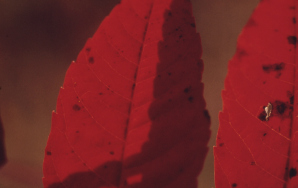A Short Short Story — The Leaves


…There is a man of our acquaintance who built a house; a real, full-sized, living house — that was made entirely of leaves. Or almost entirely of leaves. We all knew this man; he was a local. He was eccentric, but not very — he fell well within the boundaries of locally accepted eccentricity.
Yes, he had a lengthy beard; the kind of beard into which small wood-chips and pieces of dander often got tangled (for he wandered often through the woods) — but this sort of beard was coming into style at the time, and so we thought little of it. And yes, he wore overalls — but these were sensible, considering where we lived, which was northerly, north-ish, up towards Vermont, that sort of area, though we do not want to name the specific state, considering everything that happened…
And so yes, he wore overalls, and heavy, waffle-textured, long-john-ish sorts of shirts beneath them, the kind with buttons halfway down the chest, and his hair was long (though not too long), and his beard was long, and had you just driven in from the Upper East Side of Manhattan and seen him at random, coming out from a ramble in the woods, with bits of twigs clinging to his beard, you might have thought him a madman — though he was not one, nor did he seem like one, to us. To us, he fit right in.
Then he began work on his house made of leaves. An ambitious project, to be sure. He had a regular house of his own of course, but he had recently gone through a divorce, and we understood — or thought we understood — the desire to start again, to begin anew. Thus — leaves; house; abracadabra.
_____
And so one day Jim — for Jim was his name — came into the Village Tap (the local tavern) and first announced his intent to build a house made of leaves. After this, he drank two scotches, neat, and then left, leaving so quickly that as the door swung shut, his scotch glass was still rattling, quivering from being slapped down on the bar. And the next day, he began construction on the house.
Admirable resolution! Admirable resolution; or so we felt. To think of a thing and then do it. No prevaricating, no time-wastage. Decision, then action — and isn’t this as it should be, but as it almost never is? …He wasn’t back at the Village Tap the next day, for he was already busy at work — and so we raised our glasses in a silent toast, in silent honor of Jim.
And so the house began. No one thought to doubt him, or (at least initially) to question him in any way. Perhaps we are a quirky folk, but who could say “no” — who could cast aspersions against a house of leaves? Such a beautiful idea, after all. …Of course the house was not entirely built of leaves. First, Jim laid a concrete foundation and a slim wooden framework, and also installed a wood-burning stove. But as for the rest, it was leaves, leaves, all leaves.
He had a peculiar process of selecting the leaves that would form the walls of his house. It was a process that we could not quite understand. He would not select the broadest, largest, most protecting leaves for his house (except that sometimes he would). Nor would he select the prettiest, the most beautiful leaves (except sometimes he would). Nor would he reject completely ugly or scarred or broken leaves (except sometimes, etc.). …In short, his “process” seemed to be no real process it all.
Next, he would lacquer the leaves in some sort of organic compound that he had created. (Nosy neighbors often saw him stirring the goopy compound; mixing the bubbling lacquer in pots that he had set up over an outdoor Coleman camping stove.) Once the leaves were lacquered — and thus solid, like the laminated pages of books — he would staple-gun an initial leaf to the thin wooden frame (barely more than an outline) of the house, and then staple another leaf to that leaf, and then so on in outgoing, beehive-ish, radiating patterns, until he reached another wooden beam, and thus had completed one section of the wall. The result was beautiful, if we may say so. It was fall already, and the leaves were in such a multiplicity of colors as can hardly be set down on paper: yellow, red, dusky orange, deepening tan, heavy gray, faintly purple-ish taupe. It looked like a medieval tapestry. Like something lost in history but meant to be found again.
But we wondered if he would finish the house in time, for winter was onrushing, gathering up speed as it does in our part of the world.
_____
“Why do you do this thing?” a stranger, an out-of-towner, or even a neighbor would ask him. “Why a house of leaves?” …These questions could be asked now, for Jim had resumed making his regular appearances at the Village Tap. (The stress of building the house was getting to him, and he seemed to relish his scotch, his beer, far more than he previously had.) At such questions (“Why do this?”), Jim would pound the surface of the bar with his fist; not hard, but he was a big man, and the hammer of his fist had the effect of making all the bar glasses bounce quickly into the air.
“Why?” he would say. “Why — for art! For beauty! For poetry!” But there was a hard edge to his voice when he said these things; and we were not sure if he was being sarcastic or not. But certainly, such a response was enough to shut down any attempt at further inquiry.
_____
…That same night, the first snowfall hit our town. Just a minor snowstorm, but it presaged what was coming. Jim had finished the walls of the house by this point; now, in response to the snow, he increased production, using ladders and working on the roof, attaching one, two, three, four layers of lacquered leaves as a cantilevered ceiling; a slanting barricade to keep the heavy blizzards of our region from penetrating his house of leaves.
And then! Very soon after that! He was done! Completed, the house was! Jim hired a bunch of his friends with pickup trucks to haul some furniture over from his old, non-leaf-based house, and then everything was truly done. And just in time. It snowed six more inches that night.
…The next day, Jim stomped off to the Village Tap in his heavy boots, accompanied by his friends. He bought many rounds of drinks for all of those who were present, and lifted his crystalline shot-glass high in the air. “To art!” he toasted. “To beauty!” And again (we asked), was he kidding or was he not? Many thought that he was. Still, we sat and drank. …When the sky darkened early, Jim tottered off to his house of leaves, weaving significantly more than he had on his walk to the bar; his path zig-zagging, Zing back and forth — like the pattern a leaf makes, wafting back and forth before finally coming to settle on the forest floor.
After Jim’s party, Patty, the barmaid, cleaned up. Among the shot-glasses and cigarette butts and wadded-up napkins, she found one unwadded-up napkin, with a firm handwriting on it; a handwriting that was clearly done in Jim’s own hand. We — we the townspeople — have had it typed up, and after that we Xeroxed it, and now, we reproduce it here.
It is a poem, of sorts, and we are not sure if Jim wrote it himself or copied it, but we like to think that he wrote it on his own. Here is the poem:

…That was the poem which Patty found at the bar, written in Jim’s hand, as she cleaned up that night.
…And that was the last that any of us ever saw of Jim — for it snowed eight more inches that night, and then a foot that weekend, and then another foot on Tuesday, and so on, and on. …We tend to hunker down in our town during the winter, laying in supplies early, and it is not unusual to go three or four months without seeing even your best friend — save, perhaps, for accidental encounters in the grocery store, quickly rushed encounters (Hello! Goodbye!) during panicky trips made solely for emergency supplies.
So the night of the party was the last time that we saw Jim.
…And when we saw him again in the spring, he was dead.
_____
To this day, no one is sure what happened. We do not know what went wrong with Jim.
_____
Wes Morley was the first to visit the house of leaves, early in the spring, and he found Jim lying there, almost in the exact center of the living room — which was also the only room, which also constituted the entire house, for the house was composed merely of a single floor.
Jim’s body was undisturbed. Wes said that there was a peaceful aspect to it. He also said that Jim’s hands were crossed together, in a semi-X, covering his heart, almost as though he had been praying at the moment of his passage into another world… Of course we have only Wes’s word for this. But one thing was for sure: Jim was dead.
Jim was dead; but without foul play. For there was no violent aspect to anything that had happened.
But what had happened?
There are many theories. One is that the house lacked sufficient insulation, and that Jim had simply frozen to death, though this barely makes sense — why would one remain there, sitting and shuddering in a freezing house? Sure, the path to town was onerous, but Jim could have made it, despite the many feet of snow, he was quite the woodsman, and could have easily walked the mile or two to town.
…The second theory is that there was a problem with the ventilation; that Jim’s wood stove backed up; that smoke couldn’t be released and that Jim then choked to death on toxic carbon dioxide fumes. This theory, though depressing and unfulfilling, at least had the virtue of making more sense; at least to most of us, at least to the majority of us townsfolk.
…The third theory is that Jim intentionally poisoned himself somehow, in a way that was undetectable, and that he secretly wanted to die. …For most of us, this was the cut-off point where we stopped listening to the theories. For though the idea of undetectable poison lies on the very edge of plausibility, the theories do not stop there — oh no, far from it — they grow far weirder and far worse: murder by ex-wife, murder by ex-wife’s new boyfriend, home-invasion, a masked, inbred conspiracy of outsiders, self-murder, self-abuse… but never mind. We promised that we would never indulge in these theories, and we will not.
“…There was a man of double deed.” What was Jim trying to tell us here? A good question. Sadly, we are not so very good with poetry. Was he saying that his building of the house had a double meaning? Okay. That much seems clear. But from that point in the poem, everything grows weirder and weirder: “When the ship began to sail/ ‘Twas like a bird without a tail…”
If we follow the lines of the poem, then the building of the house of leaves had a double meaning, but then each of the double meanings of that had double meanings themselves, everything attaining a dual meaning — and in this way of thinking, ideas and concepts sprout and proliferate, like buds in the spring: until who can look at a thing without thinking of another thing? …Also, of course, the poem leads on to death; but then maybe death itself has another meaning; death itself might also be life, or be something else, as so many famous religions have suggested. And here we choose to stop thinking about the whole thing.
…But still, to this day, tourists, lost vacationers, wandering eccentrics — they stop by our village and they ask about the house of leaves.
“Art! Poetry!” we try to explain, when the outsiders ask about the house; but these are mere words, and sometimes, we feel we lack conviction in saying them.
_____
After Wes found the body, we buried Jim ourselves, with our own hands, a simple stone serving as a marker. For this was a thing for us to do; and no outsiders were present, were even allowed. ….As for the leaf house; it yet survives — though a few gaps have been ripped in the walls during heavy windstorms; Jim no doubt would have fixed these easily.
These days, the local teenagers mostly use the house — which is unlocked — in order to drink, and possibly do drugs, and have sex, and otherwise seek refuge with their own kind.
These days, a rumor has grown up amongst the teenagers, and among the children of the town. We buried Jim, with that simple stone as his memorial. …But as the seasons pass, more and more of them, a rumor grows and grows among the teenagers, the children, that no leaf ever falls upon his grave — not a single stray leaf, not a pile of them; not one solitary leaf, ever. The rumor grows that no leaf would dare to touch his final resting place — meaning that the grave itself is cursed, or blessèd, or both, and here again, we choose to stop thinking about it.
We ourselves have no comment on these matters. For we have learned not to traffic in rumors. And we have learned the hard way; learned the difficulty of sorting out meaning; doubled meanings, mirrored meanings. …The difficulty of sorting things out between love and truth, poetry and death, lies and art. ![]()
image – U.S. National Archives




